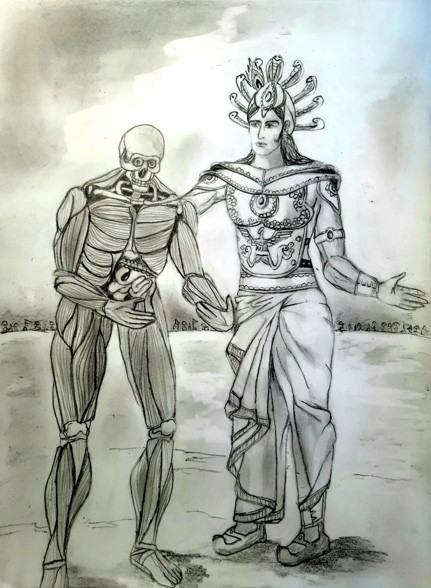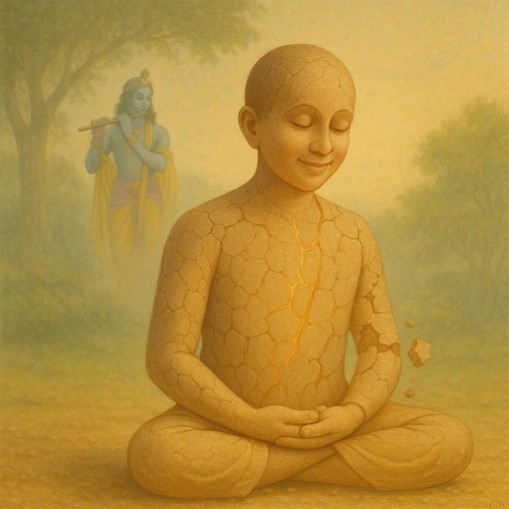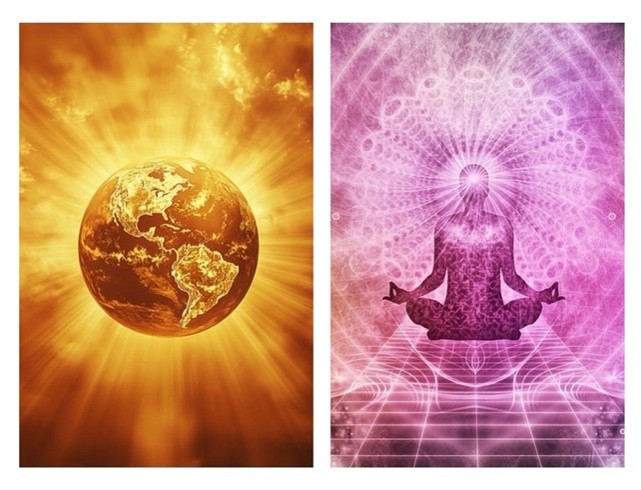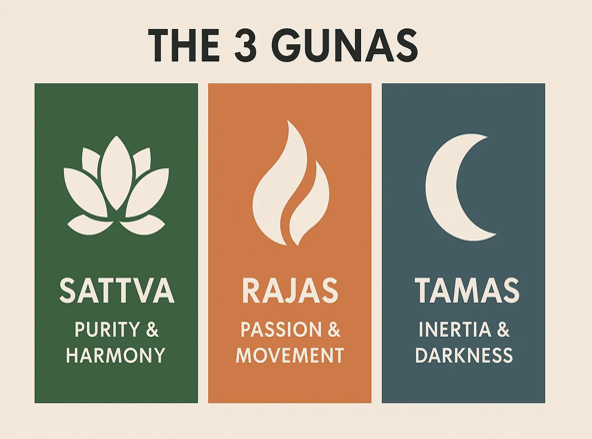By Nirooshitha Sethuram, Yogaratna
Graphics by Sheralee (Shambhavi) Hancherow
Chapter 13: Kshetra Kshetraj~na Vibhaga Yoga (The Yoga of the Field & the Knower of the Field)
Lord Krishna reveals profound insights into the nature of existence, the body and the soul.
The “field” or kshetra is the physical body and the material world that includes it. The “knower of the field” or kshetraj~na is the eternal soul or consciousness that resides within.
Krishna emphasizes that understanding this distinction is key to attaining true wisdom. It illuminates the transient nature of the physical realm and the eternal essence of the Self.
He further elaborates on the qualities of a wise person including humility, non-violence, patience and devotion. These help you transcend the material attachments of the “field.” He introduces the concept of prakriti (nature) and purusha (soul), describing their interdependence and how they play a role in the cosmic order.
This chapter also delves into the understanding of ignorance and knowledge, with true knowledge being the realization of your own Self’s unity with Supreme Being. This realization leads to liberation and eternal peace.
Through vivid metaphors and Divine insight, Krishna imparts that the ultimate truth lies in recognizing the imperishable soul as distinct from the perishable body. He stresses that this awareness enables you to navigate life’s challenges, while remaining detached from the fruits of action.
Chapter 13 serves as a spiritual guide for seekers who wish to understand the deeper dimensions of existence and the path to Self-realization.
The Dialog
Arjuna asks, “I wish to learn about the nature, the soul, the field, the knower of the field, knowledge and that which needs to be known.”
Krishna replies, “This body is the field, he who knows it is called the knower of the field. Knowing Me as the Knower in all the fields is real knowledge. All this has been sung by sages in many and different ways, presented with all reasoning as to cause and effect.
“The field is much more than your physical body. It includes the great elements*, egoism, intellect and unmanifested nature, your ten senses*, your mind and the five objects of the senses*. Also desire, hatred, pleasure, pain, your body, fortitude and intelligence.
“Knowledge includes humility, freedom from hypocrisy, non-violence, forgiveness, uprightness, service of the teacher, purity, steadfastness and self-control. Also renunciation of the objects of the senses, absence of egoism, perception of evil in birth, death, old age, sickness and pain. In addition, non-attachment, non-identification of the Self with a son, wife, home and the rest and constant even-mindedness on the attainment of the desirable and undesirable.
“Also unswerving devotion unto Me by the Yoga of non-separation, resorting to solitary places and aversion for spending time with others. Constancy in Self-Knowing and perception of the Absolute Truth – all this is declared to be knowledge. What is contrary to it is called ignorance.
“Beyond the cause and effect of this material world, the beginningless Supreme Brahman, who is neither a being nor a non-being, is to be known. This knowing is how you attain Immortality. With hands, feet, eyes, heads, mouths and ears everywhere, existing in the world, enveloping all.
“That is shining through the functions of all the senses, but without the senses; unattached, yet sustaining all; devoid of qualities, yet the experiencer of all. Outside and within all beings, the unmoving as well as the moving; incomprehensible because of His subtlety; That is near and yet far. Being undivided, That exists as if divided in all beings.
“Brahman is the sustainer of all beings, as also their devourer and generator. That, light of all lights, is beyond darkness; being knowledge, the knowable and the goal of knowledge, seated in the hearts of all. Thus the field, as well as knowledge and the knowable is described. My devotees, understanding this, enter into My Being.
“Nature and soul are beginningless. All modifications and qualities are products of nature. In the production of the effect and the cause, nature is the cause; in the experience of pleasure and pain, the soul is the cause. The soul seated in nature experiences the qualities born of nature; clinging to the qualities is the cause of one’s birth in good and evil wombs.
“The Supreme Soul in this body is also called the spectator, the permitter, the supporter, the enjoyer, the great Lord and the Supreme Self. He who thus knows nature and soul, together with the qualities, regardless of his present condition, is not reborn. He will be liberated.
“Some behold the Supreme Soul by meditation, others by yoga philosophy and others by the yoga of action (karma yoga). Others worship, not knowing this but having heard of it from others. They also transcend the path of birth and death, through regarding what they have heard as the Supreme Refuge.
“Wherever a being is born, whether moving or unmoving, know that it is through the combination of the field and the knower-of-the-field. One who sees, sees the Supreme Lord existing equally in all beings, unperishing. Because he sees the same Lord dwelling equally everywhere, he does not destroy his Self by his ego. Thus he reaches the highest goal.
“One who sees, sees that all actions are performed by nature alone and that the Self is actionless. When one sees that the variety of beings is resting in the One, spreading forth from That One alone, he then becomes Brahman.
“The Supreme Self is without beginning, possesses no qualities, is imperishable although dwelling in the body, neither acts nor is tainted! Like all-pervading ether is not tainted because of its subtlety, the Self seated everywhere in the body, is not tainted.
“Just as the one sun illumines the whole world, so also the Supreme Self illumines the whole field. They who, through the eye of knowledge, perceive the distinction between the field and the knower-of-the-field and also the liberation from the nature of being, they go to the Supreme.”
*The great elements are earth, water, fire, air and ether. Your ten senses are the five organs of knowledge (hearing, feeling, seeing, tasting, smelling) and five organs of action (handling, locomotion, speaking, excretion and procreation). The five objects of the senses are sound, touch, form/color, taste and odor.
Chapter 14: Guṇa Traya Vibhaga Yoga (The Yoga of the Three Gunas)
Here Krishna expounds the profound science of the three gunas — sattva, rajas and tamas — which constitute the fabric of all living beings and nature.
Sattva is luminous, pure and tranquil. It fosters wisdom, happiness and harmony. When sattva predominates, clarity, serenity and discernment flourish in a person’s life, leading them toward truth and higher knowledge. But sattva can also bind by clinging to joy and knowledge itself.
By contrast, rajas is restless and insatiable, propelling individuals into action, ambition and unending desire. It brings about longing, agitation and a thirst for results, which bind the soul through its endless pursuit of worldly achievements and pleasures.
The third guna is tamas, born of ignorance and darkness. It clouds discernment, giving rise to inertia, laziness and delusion. Tamas overwhelms the mind with confusion, resulting in negligence, apathy and stagnation.
Krishna reveals that these qualities arise from material nature and bind the immortal soul to the cycle of birth and death. He further explains that every human being is influenced by a unique combination of these three gunas, which determine their temperament, actions and destiny. At the time of death, the predominant guna governs one’s next birth.
Recognizing this, Krishna urges Arjuna to rise above the play of the gunas by cultivating self-knowledge, equanimity and unwavering devotion. Ultimately, He declares that the soul remains ever pure, eternal and untouched, even though embodied and seemingly affected by the gunas.
True liberation is attained when a person transcends sattva, rajas and tamas, realizing their own identity as the imperishable Self. This chapter illuminates the path to transcendence through understanding, inner discipline and devotion.
The Dialog
Krishna continues, “Those who take refuge in this knowledge attain unity with Me. They are neither born at the time of creation nor are they disturbed at the time of dissolution.
“My womb is nature (prakriti), wherein I place the seeds of living entities, from which all are born. Whatever forms are produced in any womb whatsoever, nature is their womb and I am the seed-giving father. Material nature consists of the three gunas (qualities): sattva, rajas and tamas. When the imperishable soul encounters nature, it becomes bound in the body.
“From its stainlessness, sattva is luminous and healthy. It binds by clinging to knowledge and to happiness. Rajas is of the nature of passion; it binds by clinging to action. Tamas is born of ignorance, deluding all embodied beings. It binds by clinging to carelessness, laziness and sleep.
“If the embodied one meets with death when sattva prevails, he attains the worlds of the knowers of the highest. Meeting death in rajas, he is born among those engaged in goal-driven activities. Dying in tamas, he is born in the womb of creatures devoid of reason.
“The fruit of good action is sattvik; the fruit of rajas is pain. the fruit of tamas is ignorance. When the embodied soul has risen above these three gunas, of which its body is made, it is freed from birth, death, decay and pain and attains immortality.”
Arjuna asked, “What are the marks of one who has risen above these three gunas? What is his conduct? How can you go beyond these three qualities?
Krishna said, “The one who does not hate when the three gunas bring happiness, action and delusion. He does not long for them when they are absent. Seated like one unconcerned, he is unaffected by these modes of nature.
“He is the same in pleasure and pain, dwelling in Self. He sees a clod of earth, a stone and a piece of gold with an equal eye. Wise, holding praise and blame to be the same, unchanged in honor and dishonor, he treats friends and enemies alike. He abandons all undertakings, having crossed beyond the gunas.
“One who serves Me with unswerving devotion is fit for becoming Brahman. For I am the abode of Brahman, the immortal and the immutable, of everlasting dharma and of absolute bliss.”
More to come…
- The “field” & “knower of the field.” https://pragmaticgita.com/kshetra-and-kshetrajna-vibhaga-yoga-1-to-7/
- Krishna explaining the body is the “field”. https://www.reddit.com/r/AdvaitaVedanta/comments/xo5g0c/krishna_teaches_arjuna_the_distinction_between/
- Absence of Ego https://www.jkyog.org/blog/dissolving-ego-bhagavad-gita-swami-mukundananda/
- Soul & Nature (Purusha & Prakriti) https://www.poojn.in/post/30908/purusha-and-prakriti-understanding-the-dualities-of-existence?srsltid=AfmBOooDTK2OEAvywP9Ub8eB9umBpqzoBJlkuQh87YDIa9EIlbRa1Tud#google_vignette
- Sunlit Earth https://stockcake.com/i/sunlit-glowing-earth_1312324_945176
- Supreme Self https://sdlindia.com/concept-of-aatma-soul/?srsltid=AfmBOopCJxYwomhbSAHeE2gSzoJaKkSlVR6RW7q4XH2ON5d8VTLCT2IT
- The Three Gunas https://mindfullyoga.com/what-are-the-3-gunas-in-hinduism/
- Krishna as the “seed-giving father. https://www.radhakrishnatemple.net/blog/bhagavad-gita-chapter-14-guna-traya-vibhag-yog-explained/
- Krishna, Rising above the three gunas. https://mydailysadhana.org/content/rise-beyond-three-gunas-maya-attain-god








